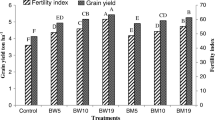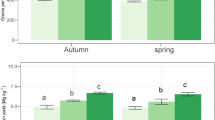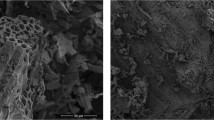Abstract
A field trial was carried out to examine the influence of residual acidified biochar (a 3:100 (w/w) mixture of citric acid and citrus wood biochar) on soil properties, growth, water status, photosynthetic efficiency, metal accumulation, nutrition status, yield, and irrigation use efficiency (IUE) of maize grown under salty soil and metal-contaminated irrigation water. The acidified biochar (ABC) was applied to faba bean in 2016/2017 in saline soil (electrical conductivity (ECe) 7.6 dS m−1) with three levels 0, 5, and 10 t ha−1 with 4 replications. The results summarized that after a year of utilization, acidified biochar still significantly affected the growth and yield by improved soil properties and decreased maize uptake of sodium by transient sodium (Na+) binding because of its high adsorption capacity. Growth, physiology, and maize yields were influenced positively by ABC application, under metal-contaminated irrigation water. It was summarized that the utilization of ABC had a significant residual (P ≤ 0.05) effect on reducing nickle (Ni), lead (Pb), cadmium (Cd), and chromium (Cr) accumulation in maize under heavy metal–contaminated irrigation water. However, more detailed open-field experiments should be carried out to assess the long-term residual impacts of ABC for sustaining maize production under biotic stress.

Similar content being viewed by others
References
Abd El-Mageed TA, El-Samnoudi IM, Ibrahim AM, Abd El Tawwab AR (2018) Compost and mulching modulates morphological, physiological responses and water use efficiency in sorghum (bicolor L. Moench) under low moisture regime. AgricWater Manage 431–439
Abd El-Mageed TA, El-Sherif AMA, Abd El-Mageed SA, Abdou NM (2019) A novel compost alleviate drought stress for sugar beet production grown in Cd-contaminated saline soil. Agric Water Manag 226(105831):1–9
Abd El-Mageed TA, Rady MM, Taha RS, Abd El Azeam S, Simpsond CR, Semida WM (2020) Effects of integrated use of residual sulfur-enhanced biochar with effective microorganisms on soil properties, plant growth and short-term productivity of Capsicum annuum under salt stress. Sci Hortic 261(108930):1–10
Abd-Alla MH, El-Enany AE, Nafady NA, Khalaf DM, Morsy FM (2014) Synergistic interaction of Rhizobium leguminosarum bv. Viciae and arbuscular mycorrhizal fungi as a plant growth promoting bio fertilizers for faba bean (Vicia faba L.) in alkaline soil. Micro Res 169:49–58
Abdel Latef AA, Tran LSP (2016) Impacts of priming with silicon on the growth and tolerance of maize plants to alkaline stress. Front Plant Sci 7:243
Abdel-Azim R, Allam M (2005) Agricultural drainage water reuse in Egypt: strategic issues and mitigation measures. Non-conventional water use: WASAMED project Bari: CIHEAM / EU DG Research
Agami RA, Saad AM, Abd El-Mageed TA, Abousekken MS, Mohamed H (2018) Role of exogenous nitrogen supply in alleviating the deficit irrigation stress in wheat plants. Agric Water Manag 210:261–270
Akhtar SS, Li G, Andersen MN, Liu F (2014) Biochar enhances yield and quality of tomato under reduced irrigation. Agric Water Manag 138:37–44
Akhtar SS, Andersen MN, Liu F (2015) Residual effects of biochar on improving growth, physiology and yield of wheat under salt stress. Agric Water Manag 158:61–68
Ali A, Guo D, Zhang Y, Sun X, Jiang S, Guo Z, Huang H, Liang W, Li R, Zhang Z (2017a) Using bamboo biochar with compost for the stabilization and phytotoxicity reduction of heavy metals in mine-contaminated soils of China. Sci Rep 7:2690
Ali HN, Saeed BN, Abdol Rahim H (2017b) Management practices using of agricultural drainage water with drip irrigation for crop production and lands sustainability in arid and semi-arid areas. 13th ICID International Drainage Workshop, Ahwaz, Iran, March. www.idwi3.org
Al-Wabel MI, Usman ARA, El-Naggar AH, Aly AA, Ibrahim HM, Elmaghraby S, Al-Omran A (2015) Conocarpus biochar as a soil amendment for reducing heavy metal availability and uptake by maize plants. Saudi J Biol Sci 22:503–511
Antonio JA, Salazar P, Barron V, Torrent J, Maria D, Campillo C, Gallardoand A, Villar R (2013) Enhanced wheat yield by biochar addition under different mineral fertilization levels. Agron Sustain Dev 33:475–484
Asai H, Samson BK, Stephan HM, Songyikhangsuthor K, Homma K, Kiyono Y, Inoue Y, Shiraiwa T, Horie T (2009) Biochar amendment techniques for upland rice production in Northern Laos. 1. Soil physical properties, leaf SPAD and grain yield. Field Crop Res 111:81–84
Bell MJ, Worrall F (2011) Charcoal addition to soils in NE England: a carbon sink with 978 environmental co-benefits? Sci Total Environ 409:1704–1714
Brewer CE, Chuang VJ, Masiello CA, Gonnermann H, Gao X, Dugan B, Driver LE, Panzacchi P, Zygourakis K, Davies CA (2014) New approaches to measuring biochar density and porosity. Biomass Bioenergy 66:176–185
Brodowski S, John B, Flessa H, Amelung W (2006) Aggregate-occluded black carbon in soil. Eur J Soil Sci 57:539–546
Cakmak I (2005) The role of potassium in alleviating detrimental effects of abiotic stresses in plants. J Plant Nutr Soil Sci 168:521–530
Calvo P, Nelson L, Kloepper JW (2014) Agricultural uses of plant biostimulants. Plant Soil 383:3–41
Chan K, Van Zwieten L, Meszaros I, Downie A, Joseph S (2007) Agronomic values of greenwaste biochar as a soil amendment. Aust J Soil Res 45:629–634
Chapman HD, Pratt PF (1961) Methods of analysis for soil, plants and water. University of California, Division of Agricultural Science, Berkeley, pp 56–63
Chen L, Yin H, Xu J, Liu X (2011) Enhanced antioxidative responses of a salt-resistant wheat cultivar facilitate its adaptation to salt stress. Afr J Biotech 10(74):16887–16896
Cheng CH, Lehmann J, Thies JE, Burton SD, Engelhard MH (2006) Oxidation of black carbon by biotic and abiotic processes. Org Geochem 37:1477–1488
Clark JS (1996) The pH values of soils suspended in dilute salt solutions. Soil Sci Soc Am Proc 30:11–14
Clark AJ, Landolt W, Bucher JB, Strasser RJ (2000) Beech (Fagus sylvatica) response to ozone exposure assessed with a chlorophyll a fluorescence performance index. Environ Pollut 109:501–507
Etesami H (2017) Bacterial mediated alleviation of heavy metal stress and decreased accumulation of metals in plant tissues: mechanisms and future prospects. Ecotoxicol Environ Saf 147:175–191
FAO (2017) Crop Statistics, FAOSTAT. Food and Agriculture Organization of the United Nations (FAO), Rome (Italy)
Glaser B, Lehmann J, Zech W (2002) Ameliorating physical and chemical properties of highly weathered soils in the tropics with charcoal - a review. Biol Fertil Soils 35:219–230
Gwenzi W, Chaukura N, Mukome FND, Machado S, Nyamasoka B (2014) Biochar production and applications in sub-Saharan Africa: opportunities, constraints, risks and uncertainties. J Environ Manag 150:250–261
Haider G, Koyro HW, Azam F, Steffens D, Müller C, Kammann C (2015) Biochar but not humic acid product amendment affected maize yields via improving plant-soil moisture relations. Plant Soil 395:141–157
Hayat S, Ali B, Hasan SA, Ahmad A (2007) Brassinosteroid enhanced the level of antioxidants under cadmium stress in Brassica juncea. Environ Exp Bot 60:33–41
Jensen ME (1983) Design and operation of farm irrigation systems. ASAE, Michigan, p 827
Jiang J, Xu R, Jiang T, Li Z (2012) Immobilization of Cu (II), Pb (II) and Cd (II) by the 1149 addition of rice straw derived biochar to a simulated polluted Ultisol. J Hazard Mater 229-230:145–150
Kabir ME, Karim MA, Azad MAK (2004) Effect of potassium on salinity tolerance of mung bean (Vigana radiata L. Wilczek). J Biol Sci 4:103–110
Kannan V, Srinivasan G, Babu R, Thiyageshwari S, Sivakumar T (2017) Effect of biochar, mulch and Ppfm spray on leaf relative water content, leaf Proline, chlorophyll stability index and yield of cotton under moisture stress condition. Int J Curr Microbiol Appl Sci 6:604–611
Karami N, Clemente R, Moreno-Jimenez E, Lepp NW, Beesley L (2011) Efficiency of greenwaste compost and biochar soil amendments for reducing lead and copper mobility and uptake to ryegrass. J Hazard Mater 191:41–48
Kim HS, Kim KR, Yang JE, Ok YS, Owens G, Nehls T, Wessolek G, Kim KH (2016) Effect of biochar on reclaimed tidal land soil properties and maize (Zea mays L.) response. Chemosphere 142:153–159
Kimetu JM, Lehmann J, Ngoze SO, Mugendi DN, Kinyangi JM, Riha S, Verchot Recha JW, Pell AN (2008) Reversibility of soil productivity decline with matter of differing quality along a degradation gradient. Ecosystems 11:726–739
Kloss S, Zehetner F, Wimmer B, Buecker J, Rempt F, Soja G (2014) Biochar application to temperate soils: effects on soil fertility and crop growth under greenhouse conditions. J Plant Nutr Soil Sci 177:3–15
Klute A (1986) Methods of soil analysis. Part-I: Physical and mineralogical methods, 2nd edn. American Society of Agronomy, Madison
Laird DA, Fleming P, Davis DD, Horton R, Wang B, Karlen DL (2010) Impact of biochar amendments on the quality of a typical Midwestern agricultural soil. Geoderma 158:443–449
Lehmann J, Gaunt J, Rondon M (2006) Biochar sequestration in terrestrial ecosystems - a review. Mitig Adapt Strateg Glob Chang 11:403–427
Lehmann J, Rillig MC, Thies J, Masiello CA, Hockaday WC, Crowley D (2011) Biochar effects on soil biota - a review. Soil Biol Biochem 43:1812–1836
Lynch JP, St Clair SB (2004) Mineral stress: the missing link in understanding how global climate change will affect plants in real world soils. Field Crops Res 90:101–115
Major J, Rondon M, Molina D, Susan JR, Lehmann J (2010) Maize yield and nutrition during 4 years after biochar application to a Colombian savanna oxisol. Plant Soil 333:117–128
Malcovska SM, Ducaiova Z, Backor M (2014) Impact of silicon on maize seedlings exposed to short-term UV-B irradiation. Biologia 69:1349–1355
Masto RE, Ansari A, George J, Selvi VA, Ram LC (2013) Co-application of biochar and lignite fly ash on soil nutrients and biological parameters at different crop growth stages of Zea mays. Ecol Eng 58:314–322
Mau AEE, Utami SR (2014) Effects of biochar amendment and arbuscular mycorrhizal fungi inoculation on availability of soil phosphorus and growth of maize. J Degrad Min Lands Manag 1:69–74
Maxwell K, Johnson GN (2000) Chlorophyll fluorescence-a practical guide. J Exp Bot 51(345):659–668
Oguntunde PG, Fosu M, Ajayi AE, Van De Giesen N (2004) Effects of production on maize yield, chemical properties and texture of soil. Biol Fertil Soils 39:295–299
Page AI, Miller RH, Keeny DR (1982) Methods of soil analysis. Part II. Chemical and Microbiological Methods, 2nd ed. Am Soc Agron Madison WI USA, pp 225–246
Paradelo R, Vazquez-Nion D, Silva B, Gonzalez A, Barral MT (2016) Acidification of mixtures of granite powder and compost for reuse in plant production. Comp Sci Uti 24:1e10
Premchandra GS, Saneoka H, Ogata S (1990) Cell membrane stability, an indicator of drought tolerance as affected by applied nitrogen in soybean. J Agric Sci Camb 115:63–66
Rady MM, Abd El-Mageed TA, Abdelhamid MT, Abd El-Azeam MMM (2018) Integrative potassium humate and biochar application reduces salinity effects and contaminants and improves growth and yield of eggplant grown under saline conditions. Int J Empir Educ Res 1:37–56
Ramzani PMA, Iqbal M, Kausar S, Ali S, Rizwan M, Virk ZA (2016) Effect of different amendments on rice (Oryza sativa L.) growth, yield, nutrient uptake and grain quality in Ni-contaminated soil. Environ Sci Pollut Res 23:18585–18595
Rizwan M, Ali S, Abbas T, Adrees M, Zia-ur-Rehman M, Ibrahim M, Abbas F, Qayyum MF, Nawaz R (2018) Residual effects of biochar on growth, photosynthesis and cadmium uptake in rice (Oryza sativa L.) under Cd stress with different water conditions. J Environ Manag 206:676–683
Rondon MA, Lehmann J, Ramírez J, Hurtado M (2007) Biological nitrogen fixation by common beans (Phaseolus vulgaris L.) increases with bio-char additions. Biol Fertil Soils 43:699–708
Seehausen M, Gale N, Dranga S, Hudson V, Liu N, Michener J, Thurston E, Williams C, Smith S, Thomas S (2017) Is there a positive synergistic effect of biochar and compost soil amendments on plant growth and physiological performance? Agronomy 7:13
Semida WM, Abd El-Mageed TA, Howladar SM (2014) A novel organo-mineral fertilizer can alleviate negative effects of salinity stress for eggplant production on reclaimed saline calcareous soil. Acta Hortic 1034:493–499
Semida WM, Beheiry HR, Setamou M, Simpson CR, Abd El-Mageed TA, Rady MM, Nelson SD (2019) Biochar implications for sustainable agriculture and environment: a review. S Afr J Bot 127:333–347
Shen YS, Wang SL, Tzou YM, Yan YY, Kuan WH (2012) Removal of hexavalent Cr by coconut coir and derived chars—the effect of surface functionality. Bioresour Technol 104:165–172
Sinclair TR, Ludlow MM (1986) Influence of soil water supply on the plant water balance of four tropical grain legumes. Aust J Plant Physiol 13:329–341
Sohi S, Krull E, Lopez-Capel E, Bol R (2010) A review of biochar and its use and function in soil. Adv Agron 105:47–82
Sun H, Hockaday WC, Masiello CA, Zygourakis K (2012) Multiple controls on the chemical and physical structure of biochars. Ind Eng Chem Res 51:3587–3597
Thies JE, Rilling MC (2009) Characteristics of biochar: biological properties. In: Biochar for Environmental Management
Thomas SC, Frye S, Gale N, Garmon M, Launchbury R, Machado N, Melamed S, Murray J, Petroff A, Winsborough C (2013) Biochar mitigates negative effects of salt additions on two herbaceous plant species. J Environ Manag 129:62–68
Uchimiya M, Wartelle LH, Klasson KT, Fortier CA, Lima IM (2011) Influence of pyrolysis temperature on biochar property and function as a heavy metal sorbent in soil. J Agric Food Chem 59:2501–2510
Uzoma KC, Inoue M, Andry H, Fujimaki H, Zahoor A, Nishihara E (2011) Effect of cow manure biochar on maize productivity under sandy soil condition. Soil Use Manag 27:205–212
Vaccari FP, Maienza A, Miglietta F, Baronti S, Di Lonardo S, Giagnoni L, Lagomarsino A, Pozzi A, Pusceddu E, Ranieri R, Valboa G, Genesio L (2015) Biochar stimulates plant growth but not fruit yield of processing tomato in a fertile soil. Agric Ecosyst Environ 207:163–170
Van Hoorn JW, Katerji N, Hamdy A, Mastrorilli M (2001) Effect of salinity on yield and nitrogen uptake of four grain legumes and on biological nitrogen contribution from the soil. Agric Water Manag 51:87–98
Vodyanitskii YN (2016) Standards for the contents of heavy metals in soils of some states. Ann Agrar Sci 14:257–263
Wang T, Arbestain C, Hedley M, Bishop M (2012) Chemical and bioassay characterisation of nitrogen availability in biochar produced from dairy manure and biosolids. Org Geochem 51:45–54
Wolka K, Melaku B (2015) Exploring selected plant nutrient in compost prepared from food waste and cattle manure and its effect on soil properties and maize yield at Wondo Genet, Ethiopia. Environ Syst Res 4:9
Yamato M, Okimori Y, Wibowo IF, Anshori S, Ogawa M (2006) Effects of the application of charred bark of Acacia mangium on the yield of maize, cowpea and peanut, and soil chemical properties in South Sumatra, Indonesia. Soil Sci Plant Nutr 52:489–495
Yeboah E, Ofori P, Quansah GW, Dugan E, Sohi SP (2009) Improving soil productivity through biochar amendments to soils. Afr J Environ Sci Technol 3:34–41
Yuan JH, Xu RK (2011) The amelioration effects of low temperature biochar generated from nine crop residues on an acidic Ultisol. Soil Use Manag 27:110–115
Author information
Authors and Affiliations
Corresponding author
Additional information
Responsible editor: Gangrong Shi
Publisher’s note
Springer Nature remains neutral with regard to jurisdictional claims in published maps and institutional affiliations.
Rights and permissions
About this article
Cite this article
Abd El-Mageed, T.A., Abdurrahman, H.A. & Abd El-Mageed, S.A. Residual acidified biochar modulates growth, physiological responses, and water relations of maize (Zea mays) under heavy metal–contaminated irrigation water. Environ Sci Pollut Res 27, 22956–22966 (2020). https://doi.org/10.1007/s11356-020-08847-5
Received:
Accepted:
Published:
Issue Date:
DOI: https://doi.org/10.1007/s11356-020-08847-5




